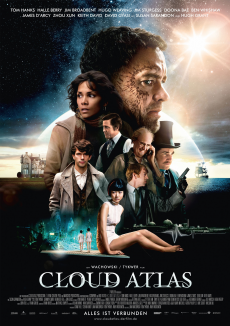
First published in 2004, David Mitchell’s (no, not the comedian) novel ‘Cloud Atlas’ is undoubtedly unique. Detailing snapshots of six, seemingly unconnected lives, settings ranging from nineteenth century America, to a post-apocalyptic future, the novel is exceedingly artistic in its presentation. Its overarching tone of mystery, as well its mesh of different genres, and writing styles, act as a reminder to the reader that literature is an art form. Although the text should receive more appreciation for the format of the writing, rather than the writing itself, this exercise in story telling manages to enchant and amaze due to the unexplained link between the six protagonists allowing the reader themselves to complete the puzzle of the ‘Cloud Atlas’.
The first story is titled ‘The Pacific Journal of Adam Ewing’, and begins with Doctor Ewing writing of his travels throughout the lands of the South Pacific. Observing the oppression of one island’s native people, he appears to feel guilt, but offers little help to the suffering. That is, until one man stows away on Ewing’s ship, begging the man not to tell the crew, lest he be killed. However, halfway through the tale, the story stops, and is replaced by another.
‘Letters from Zedelghem’, is from the point of view of young musician Robert Frobisher, to Rufus Sixsmith. Set in 1931, Frobisher is employed as an assistant to a nearly blind, and dying once great composer, but was only accepted due to a falsified identity. Incidentally, Frobisher is currently obsessed with Dr Ewing’s Pacific Journal, captivated by the story and unable to find the second half. Similar to its predeceasing tale, the letters halt halfway, and the readers are pulled into the 1970s, beginning to tail the trail of investigatory journalist Luisa Ray.
Exploring a new, allegedly unsafe power plant, Ray runs into Rufus Sixsmith, now an old man, who notices that she has the exact same birthmark as Frobisher. Just as Sixsmith agrees to give her an inside glance at the station, he is assassinated, this section of the novel ending with Luisa, and her car, being rammed into a river. Interestingly, this is the first story in the novel to be written in third person, though its connection to the fourth story provides this change in format with an explanation.
‘The Ghastly Ordeal of Henry Cavendish” is arguably the most light-hearted tale of the set. The elderly publisher mentions a distaste for the prospective novel “Half Lives: The First Luisa Ray Mystery”, before becoming trapped in an inescapable nursing home. Set in modern-day Scotland, this is the only other piece to be written in third-person, which is later explained by its connection to the fifth story.
The first tale from a future earth, “An Orison of Sonmi-451” is a cliché sci-fi dystopia. Sonmi, the protagonist, is a Fabricant, designed to work in a fast-food chain for her entire existence. That is, of course, until some rebels free her, starting to lead a rebellion. Finally being able to explore the culture of the world around her, she watches a film known as ‘The Ghastly Ordeal of Henry Cavendish”, and becomes inspired by his fighting spirit. However the fact that the story is in the form of a testimony hints that her aims are not achieved.
An age later, in a post apocalyptic wasteland of what once was Hawaii, Zachary’s story of ‘Sloosha’s Crossin’ an’ Ev’rythin’ After’ follows his adventure from his peaceful farming village, where they coincidently worship a goddess called Sonmi, to the top of Mauna Kea volcano, in order to help a woman from a more technologically advanced race retrieve some old the “Old-Un’s” supplies. As the central tale, this is the first complete text of the novel, which rapidly zooms out, finishing first Sonmi’s testimony, Cavendish’s ordeal, Luisa’s mystery, Frobisher’s letters, and finally, Ewing’s journal.
Although each has the birthmark of a shooting star, the connection between the protagonists is never explained. The difference in eras for each could give evidence for reincarnation of one soul. The fact that they are connected by the most tenuous of links could support the notion of a grand design, or destiny. Mitchell choses to abstain from providing an explanation, which makes the novel that much more fantastical. The breaks in the stories, each a purposeful cliff-hanger, compel the reader to continue, demonstrating the truth in one of the novel’s most aphoristic quotes: ‘A half-read book is a half-finished love affair.’
Image: http://www.moviepilot.de/files/images/0825/6936/cloud-atlas-poster.jpg

0 Comment:
Be the first one to comment on this article.